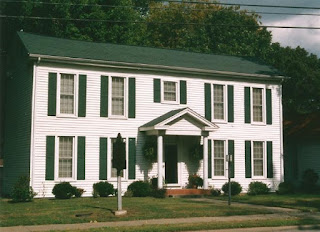Fishtrap was located in the area on Hwy. 132 on the Crittenden County side of Tradewater River. The Enon church sat upon the hill near the village.
The name was derived from
the fact that people took nets and put them in the Tradewater River
to catch fish. At this time period the river was navigational for
quite some distance up stream from the Ohio River by row boat.
Just when the village
became known as Fishtrap has been lost to history, but there were two
general stores there at one time, where they sold everything from ten
penny nails to material for ladies to make their dresses, coal oil
for lamps (kerosene) that people used following the end of the candle
era. One of the stores was owned by Nace Prow, and run by his wife
and daughters, Inez, Ruby, Grace, Crystal and son Thomas.
There was also a sawmill
not far from Fishtrap. There were roads running east and west
through this tiny village and one north and south. The business
section was on the east-west roadway. There was a ferry run by Mr.
James "Bud" Little family and they lived on the east-west
roadway.
The memory of any place great or small
is made important because of its people, so we must begin with the
residents. Upon a hill overlooking the village of Fishtrap was James
Titherington and wife, Fannie H.
On the same hill looking down at the
village was the home of Wesley M. Babb and his wife, Margaret and
son, Roscoe, and daughters, Dora and Iva.
Mrs. Harriet Towery, widow of Samuel
Towery, and daughters, Mary and Margaret lived by the side of the
road just north of Enon General Baptist Church, which was east of the
road.
Other people and families who were
considered part of the area of Fishtrap were: Edward G. Powell, with
his wife Mary V. and their children; Charlie, Rosa E., John, and
brothers Robert H., Walter R. and Thomas E. Powell.
More familes were – Daniel S. Babb
and wife Rebecca (Brantley) and daughter, Ettie.
John R. Towery and wife Susan (Ford).
Susan was the first wife of Henry Bern Simpson and they had children,
Henry and Susan Simpson. Henry Bern and Susan were the grandparents
of Eugene Simpson. Ewell and Susan (Martin) Little and their
children, Oscar, Ercie and Linnie.
Doctor Jacob Martin and his second wife,
Mattie Hubbard (his first wife was Margaret McDowell) lived near Red
Top School.
John Walter and Dollie "Byrd"
Martin and their sons- Lacy, Vernis, Amos, Robert and William and
daughters, Stella, Lossie and Sadie. George Martin and wife Laura E.
(Canada), and their daughter Vicie L. and son Joseph E.
John Walter Martin
lived on the road down to the river where in summer when the water
was low people forded the river. Just above this place was a deeper
place in the river where the Enon Church baptized people upon joining
the church.
Sarah Wood, known as "Aunt
Sallie" and her sons, David and Thomas Wood.
Milton Woodall and
his wife, Laura B. (Wood), with son Robert G. and daughters Carol,
Marie and Shirley.
There was James Franklin O'Neal, known
as Uncle Frank and his wife Mary.
Abednego and Isabelle Martin Morrow
lived at the top of the hill from Enon Church with their family,
which included - Sarah E. Morrow who married Thomas Wood, Thomas
Morrow who married Leatha Brown, Samuel Morrow who married Mary Ruth
Stephens and John Walter Morrow who married Zelma Brown Fox. John
Walter and Zelma had no children but raised her children, Evelyn and
Harry Fox. Katherine Morrow, who married Sylvester Reel, (he came
here as overseer of the building of the new iron bridge), they became
one of the store owners at Fishtrap about 1924, George Lewis Morrow
who married Josie Creasy, Alman Remus Morrow, who married Edna
Martin, and Jacob Demetrius Morrow who married Opal Duke and became a
Methodist Preacher. Abednego Morrow was the sexton and care taken of
Enon Church later in life.
Ben Price and
family lived there just south of the Abednego Morrow family.
All the people did not live in the
village, but were considered part of the Fishtrap community.
(This history was written by Sybil Morrow Hunt)

